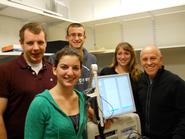
The total number of students on Hamilton’s campus may be smaller than an entire graduating class at big research universities, but that doesn’t mean Hamilton’s research opportunities are any more limited. In fact, as Matthew T. Farrington ’12, Diane Paverman ’13, Spencer Gulbronson ’12, Peter Lauro ’12 and alumnus Sam Hinks ’11 are discovering, research at Hamilton is just as engaging as it can be at large universities. The students are working with Professor of Computer Science Stuart Hirshfield to determine if computers can recognize the unique “signature” of a user’s brain.
“The research that we are doing is literally on the cutting edge with potential real-world applications that could radically change the way humans interact with computers,” Farrington said. “The research experience has been fantastic.”
Their current project evolved out of research that the students began last summer to determine neurological responses to anxiety in computer users. The experiment utilized functional Near-Infrared Spectroscopy (fNIRS) technology to measure user’s brain activity by monitoring blood flow. The research on neurological emotional responses was quite successful: by the end of the study, the students were able to conclusively determine what emotions participants were feeling by looking at brain scans.
“Many of the novel ideas that contributed to the success of the project were contributed by the research team,” Professor Hirshfield said.
After developing a proven algorithm to identify mental states, the team decided to try and apply the algorithm to identifying people—not just their emotions.
With that end in mind, the research team created a new experiment to provoke certain patterns of brain activity. Each participant puts the fNIRS cap on and then is instructed to repeatedly perform several mental tasks like basic addition or mental repetition of their home phone number. Rest periods are interspersed so that the research team can record what the subject’s normal brain patterns are. An algorithm specifically constructed for the experiment by Sam Hinks ‘11 then analyzes the raw data. The research team hopes that the recorded brain wave patterns will be unique enough to recognize each user.
Study participants are members of Professor Hirshfield’s Explorations in Computer Science (COMP SCI 105) class, many of whom are first years and sophomores who are being exposed to the research element of computer science for the first time.
“I completely re-wrote the syllabus [for the class] so they could participate,” Professor Hirshfield said. “My hope is that this will make the topic of human-computer interface even more exciting for them.”
The students have enjoyed the experience, although Garret Wyckoff ’14 reports that participating in the experiment “was more stressful than I had anticipated.” He added that “it’s pretty cool to help out cutting edge research.”
Although the research is not yet complete, Professor Hirshfield is optimistic. “The results we have gotten to date are very encouraging, and will only get better,” he said. “Our work has been yielding success rates in the 90 percent range, which is stunning. We have already had papers co-authored by Hamilton students accepted into international conferences.”
Like all research, practical application provides much of the impetus behind the project. One of the most immediate is the use of a user’s brain scan as a security measure. In this instance, a person could be identified “by simply standing in front of…some kind of wireless fNIRS device while thinking their ‘pass-thought,’” Paverman said.
“Passwords can be forgotten, and key cards can be stolen—but you can’t lose your brain,” Farrington added.
Lauro has identified another application: “this type of technology could one day help quadriplegics move around a wheelchair with their thoughts, simply by thinking ‘forward,’ ‘backward,’ or ‘left.’”
Hirshfield and the research team are quick to acknowledge, however, that any practical applications can only be implemented after the price of fNIRS technology comes down. “History tells us that this is likely to occur,” Hirshfield said.
Whatever the potential uses for this technology, it’s already made a very positive impact on the research team. Paverman calls the research experience “an incredible eye-opener. After working on the research team, I have a much clearer idea of what sort of career I’d like to pursue after college.”
“I think it’s amazing that undergraduates have the opportunity to work on such cutting edge research in a very supportive environment,” Farrington concluded.
-- Author John Boudreau '14 is a graduate of Burnt Hills-Ballston Lake High School (NY).
Posted December 15, 2011
